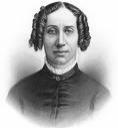Clarina Irene Howard Nichols 1810 - 1885
December 06, 2007
 Clarina Irene Howard
Nichols 1810 -
1885 worked alongside homeopath Elizabeth Cady
Stanton
and homeopathic supporters Susan B
Anthony,
Lucretia
Mott,
Martha Coffin Pelham
Wright,
Matilda Joslyn
Gage
and many others on Women’s Rights, abolitionism and Married Women’s
Property Rights. Nichols merited her own chapter in Susan B
Anthony’s
History of Woman
Suffrage, fine
praise indeed!
Clarina Irene Howard
Nichols 1810 -
1885 worked alongside homeopath Elizabeth Cady
Stanton
and homeopathic supporters Susan B
Anthony,
Lucretia
Mott,
Martha Coffin Pelham
Wright,
Matilda Joslyn
Gage
and many others on Women’s Rights, abolitionism and Married Women’s
Property Rights. Nichols merited her own chapter in Susan B
Anthony’s
History of Woman
Suffrage, fine
praise indeed!
Pioneering Crusade for Women’s Rights… Clarina I. H. Nichols one of America’s first female newspaper editors. A founder of the American women’s movement, Nichols had experienced some of the most terrible heartbreak a married woman could experience, yet she not only faced head-on the challenges of financial hardship and single motherhood; she also crusaded to improve life for women and remedy their mistreatment.
Journalist, reformer, woman’s rights activist. Divorced from Justin Carpenter in 1843, she began writing for the Windham County Democrat. Married to newspaper publisher George W. Nichols in 1843, she edited the Democrat, gradually broadening the paper’s range to include literary pieces and editorials in support of various reform movements, including Married Woman’s Property Rights and, later, woman’s suffrage.
Vice-President at the Syracuse National Women’s Rights Convention in 1852, the convention where Matilda Joslyn Gage made her debut, Nichols was an early, staunch woman’s rights activist who decried woman’s legal liability, especially the right of men to take a woman’s property from her after marriage. Nichols also decried the double standards due to custom.
The Democrat ceased publication in 1853, Nichols along with her 2 older sons traveled to the Kansas Territory. She returned to Vermont and moved to Kansas with her husband, who died in the summer of 1855.
She continued to contribute articles on woman’s rights to the Lawrence Herald of Freedom and the Topeka Kansas Tribune, to travel and speak on behalf of woman’s rights, to successfully lobby the Wyandotte constitutional convention, to campaign for the ratification of the state’s constitution, and to address the state legislature on women’s issues.
During the Civil War, she moved to Washington DC to work at a home for the relief of destitute “Colored Women and Children.” She returned to Kansas in 1866, and in late 1871 moved to Mendocino County, California. She continued her woman’s rights activism throughout her life.
In Preceding Causes (Buhle and Buhle, p. 66), Matilda Joslyn Gage wrote, “In 1847, “Clarina Howard Nichols, in her husband’s paper, addressed to the voters of the State of Vermont a series of editorials, setting forth the injustice of the property disabilities of married women. ”
Nichols was a journalist, lobbyist and public speaker involved in all three of the major reform movements of the mid-19th century: temperance, abolition, and the women’s movement that emerged largely out of the ranks of the first two.
Born in West Townshend, Vermont, into a prosperous New England family, Nichols fell on hard times after a disastrous early marriage. Supporting herself and her children on “women’s wages†— one-half to one-third what men received for similar work — she began writing for a newspaper in Brattleboro, Vermont, the Windham County Democrat.
She married the editor and publisher, George Nichols; when he became an invalid, she quietly took over his duties at the paper. Through her new profession, she was introduced to various reform movements of the day — temperance, women’s rights, anti-slavery, dress and diet reform — and embraced many of them. She helped organize the fledgling women’s movement in the East.
When the Kansas-Nebraska Act of 1854 threatened to establish slavery outside of the South, Clarina Nichols uprooted her family to become a pioneer and activist in Kansas. Her efforts helped catapult her adopted state into the forefront of women’s rights, gaining the respect and support of such women as Susan B. Anthony and Elizabeth Cady Stanton.
During the course of an ever-busy life, Clarina Nichols served as teacher, lecturer, editor, writer, farmer, lay doctor and lawyer, government clerk, matron in a home for destitute black children and widows, and conductor on the Underground Railroad. She died in 1885 in California, where she pioneered and agitated right to the end.